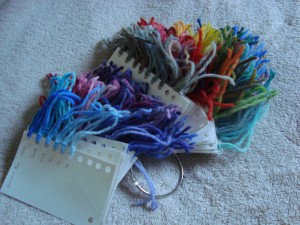Entries tagged with “samples”.
Did you find what you wanted?
Fri 6 Apr 2012
…makes Jack a dull boy, right?
Since most everyone seemed to be leaning toward play (and since I had some pretty strong leanings in that direction myself), I decided to try spinning the second half of the gradient as a short repeat yarn.
As instructed, I kept it simple. No overthinking…not even a bit. (Who me? Overthink? Never!)
I split the top along its full length, making 10 very narrow strips.
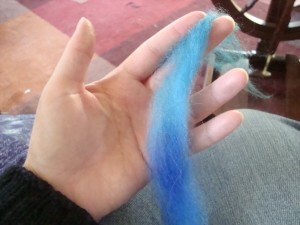
Then I spun them, one after the other until I ran out. (I was also careful to keep the cats out of the pile while I was spinning. This was critical, and proved to require more attention than I expected. Apparently lots of little strips of fiber = warm nest in the mind of a cat.)
I chain plied the singles like I did for the first skein, and ended up with about 2 yard lengths of each color (compared to about 20 yards per color in the previous skein). You can see the difference in the color distribution here:
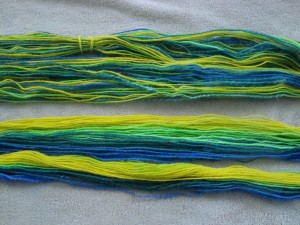
And the two skeins together:
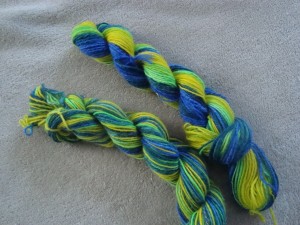
True to form, I like the long repeat version better in the skein, but I’m really not sure which I would prefer in the knitting.
I’d started out spinning this yarn expecting it to become a pair of socks, so I spun a (slightly heavy) sock weight. But then I was thinking about it, and I wasn’t sure that I wanted that long a gradient along the length of just one sock. That’s where the possibility generator kicked in and suggested that shorter repeats would be nice, so that there would just be a few rounds of each color in repeating stripes.
For a sock, I think I’d much prefer the shorter repeat version. I’d guess that there would be 3, maybe 4 rows per color, and then the colors will repeat every half inch or so, for the full length of the sock.
If I were to knit this into a shawl or a larger garment, then the long repeat version would look really good striped with a darker solid color. Of course, you could also alternate sections of long and short repeats to get all kinds of interesting combinations, too.
Because this is me, I no longer want to use this yarn for socks. My brain somehow manages to take a sharp left turn every time I sit down to think about knitting socks. Sweaters and shawls and bigger things are just much more exciting for some reason. (Also, I like my socks to match, which might be hard with this yarn now.)
Last night, I was having visions of a stranded colorwork bag, with the bright yarn worked on a dark blue background. But today, a mischievous little voice is suggesting that they would look very nice woven.
I said I didn’t overthink the spinning. I didn’t promise anything at all about the using of the yarn.
(Of course, all these ideas just mean more decisions, but that woven idea is pretty sticky. I think it might win.)
Thu 25 Aug 2011
As I mentioned the other day, Linda put a bug in my ear about pansy purple. When I looked at my sample cards, though, I found that there wasn’t much to choose from. I only had two cards of dyes straight from the jar, with no real color mixing studies. And so I set about making more purples.
The opportunity to sample is one of my favorite things about working in a new color family. It gives me a chance to combine dyes in ways I haven’t thought of before, and it widens my palette at the same time.
This time, it also gave me the chance to try some new dyes. I have 8 or so new dye colors that I’ve bought over the past year but haven’t played with yet. That’s partly because there is so little time, but it’s also partly because there can be freedom in a small palette. Still, there is nothing quite as exciting as adding new colors to the collection. Since I was planning to play with purples, I chose the colors closest to red and blue, and made up standard samples for Turquoise, Brilliant Blue, Cherry Red, and Vermilion.
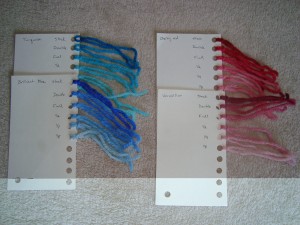
(Sorry about the strange photo – WordPress is refusing to upload that picture nicely, for some reason. Just imagine that the whole picture were as bright as that bottom bit…I have no idea why it’s having trouble with that. It looks fine on my computer.)
Then I took the reds and mixed them with a selection of my favorite blues and blue-greens. I only did these in two dilutions; one very concentrated, and one pretty dilute. That should be enough to give me an idea of the range of colors available from each combination.
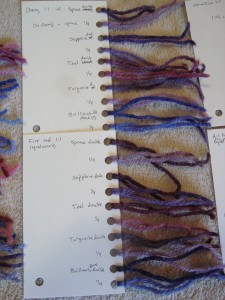
Next, I took my stock purple and burgundy dyes, and added reds and blues to see what colors I could tease out of them. I ended up with a range all the way from rosy pink to periwinkle blue; lots of colors to choose from.
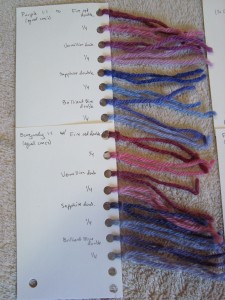
And then, since I knew I was looking for bluish-purples for the pansies, I picked my favorite color combination so far, and did a 2:1, a 1:1, and a 1:2 mixture of a purple and a blue to get the full range of colors possible from those two dyes. (The top card in this photo is another red-mixed-with-blue; the bottom two are the changing ratio set.)
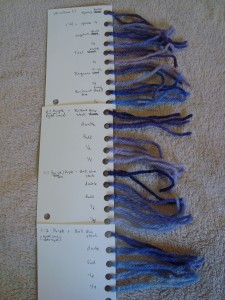
There are so many great colors in these samples! I am sure we’ll see many of them again, and I’m excited to add so many more colors to the sample collection. Having new colors always invites new combinations, and I am getting quite a collection. Just think of all the possible colorways!
Sun 14 Aug 2011
Since I suddenly find myself with an embarrassment of wool types to play with, I thought I’d do a bit of a comparative study.
I started out by pulling a lock of wool from each of the different fiber preparations that I have, and then began organizing them, first by staple length:
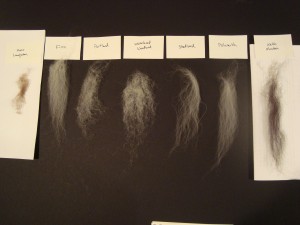
From left to right: Manx Loaghtan < Finn < Portland < Whitefaced Woodland < Shetland < Polwarth < Welsh Mountain
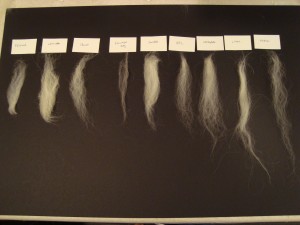
< Falkland < White Welsh < Cheviot < Norwegian Gray < Corriedale < Blue Faced Leicester < Wensleydale < Lincoln < Masham
I noticed very quickly that staple length had very little do do with the coarseness of the fiber. Just comparing the four longest staple lengths, you can see what a difference there is in coarseness of the fiber. The White welsh (the shortest of the four) is incredibly hairy, with guard hairs that are almost like fine wire. The Lincoln is also pretty hairy, but the Masham is actually quite fine.
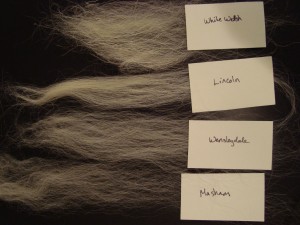
Grouped according to coarseness, I get the following:
Finn < Falkland < Polwarth < BFL < Shetland < Manx Loaghtan < Portland < Cheviot < Masham < Wensleydale < Corriedale < Welsh Mountain < Whitefaced Woodland < Norwegian Gray < Lincoln < White Welsh
The Norwegian Gray and Lincoln really are very coarse; they feel more like human hair than wool. The stiffness of the hairs will make them poke out of a spun yarn, and it will be more likely to feel itchy (think low-quality alpaca, mohair or cashmere that hasn’t been fully dehaired).
Still, I noticed that some of the fibers were more scaly than others, too. When drafted, some of the wools stuck together strongly, and some pulled out pretty easily. The ones that slipped easily felt softer, even if they had a coarser fiber. I think this scaliness is also part of what makes wool feel itchy. Ranking according to scaliness, then, I got this ordering:
Manx Loaghtan < Finn < Polwarth < Falkland < Shetland < BFL < Wensleydale < Masham < White Welsh < Corriedale < Norwegian Gray < White Woodland < Portland < Cheviot < Welsh Mountain < Lincoln
By this ranking, even the White Welsh with its wiry guard hairs is smoother than the Lincoln, which is a very grabby fiber. Both the Wensleydale and the Masham are very long-stapled fibers, but they are about as “sticky” as BFL (which is not very sticky).
I imagine that these “scalier” fibers will felt very well, though I haven’t tested that to be sure. Still, if I were looking for a rugged wool to felt into hard-wearing (but not particularly soft) items, Lincoln would probably be my first choice. White Welsh might work well here, too, since it has so many fine fibers mixed in with the coarse ones. The finer fibers might help the felt hold together nicely. Honestly, I can’t imagine using the White Welsh for much else; those guard hairs are just too stiff (and too plentiful) for me.
For spinning and knitting, I would happily use any of the finer fibers. I was surprised to find that Corriedale – which is one of my go-to wools – is so high up on the coarseness scale. I would have expected it to be much closer to the fine fibers, but it’s pretty far down the list. Unsurprisingly, my favorite “special” fibers like Finn, Falkland, Polwarth and BFL are at the fine end of the spectrum. I was surprised and somewhat amused to realize that, with all this wool in the house, I have no Merino to compare to. It’s never been a must-have for me, and it’s apparently faded out of my collection entirely now. I wish I had a little to compare to these other breeds, though, as a standard yardstick measure for fineness.
From the longwools, I would definitely knit/spin with the Masham and the Wensleydale. I think they will probably make a slightly coarser yarn, but one that’s comparable to Corriedale, which I don’t find itchy at all. It will be really fun to work with a staple that long, too. For me, BFL is a long staple at 5-6 inches; both the Wensleydale and the Masham are pushing 9 or 10. I think that the Cheviot will also be similar to Corriedale, and the Portland and White Woodland may be a little less soft.
The Norwegian Gray is an interesting fiber. It is very coarse and heavy, but it isn’t terribly scaly. It feels almost like a coarse alpaca, with that similar oily texture to it. I don’t really know how it will spin up, but it will be interesting to try.
The Manx Loaghtan is completely different than the rest. It has an incredibly short staple, and looks like a very delicate fiber. This particular preparation is not very good (I was warned before I bought it); it’s full of vegetable matter, and it looks like it has a fair number of second cuts. Still, it is very, very short and a little slippery, and it reminds me of the exotic fibers like Yak or Bison. I’m not sure how it will spin up, but it will be interesting to see if it is as soft.
Of course, now that I know a little more about these fibers, I need to start coming up with projects that will let me use them to their best advantage. I am thinking that the coarser fibers might make good wools for rug weaving. I’ve never tried that before, but having a rugged fiber to begin with seems like a good start for something meant to be walked on. The fine fibers will probably turn into garments of some kind. I’m also considering spinning up some samples for another side-by-side study, which would let me test some of my guesses about how these wools will behave. We’ll see if I manage to get to it before getting distracted, but I think it would be interesting to see how these different wools behave when spun, especially how the coarseness and scaliness play into the final texture of the yarn.
Thu 26 May 2011
This has been one of those weeks where I find myself saying “what, Thursday already?” Since it’s almost the weekend again, I suppose it’s about time that I post about what I did last weekend.
First, I finished up the leftovers from my doubleweave workshop. There were about 2 yards of warp left over, and the fabric was only about 4 inches wide. What do you do with such a small strip of fabric? Well, I made coasters.
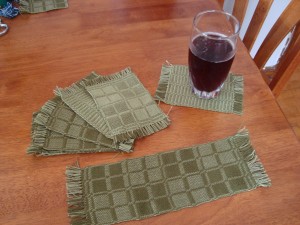
I made some with a dark weft, and some with a light weft. And then I repeated the edging pattern over and over again to make one that looks like it has zigzags all along it (those are my favorites).
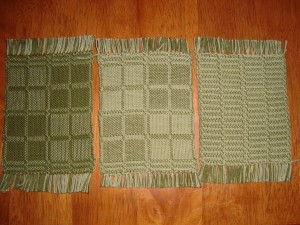
I just love these. We’ve been needing new coasters for a while now, and I’m thrilled to bits with my little magic carpets. (Though they may have had a certain Disney song stuck in my head all weekend.…)
Then, I wove the last few feet of warp on the big loom, so that it will be ready to return next weekend while we have the truck to move Branden to Chicago.
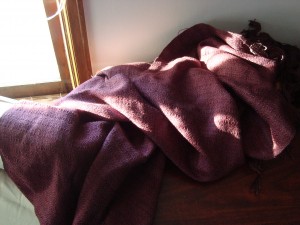
I can’t remember if I’ve blogged about this one before. It’s a rayon warp, with Madeline Tosh laceweight as the weft. The colors are very similar, but the two yarns look different in the light, and the subtle color gradations in the laceweight make for pretty contrast.
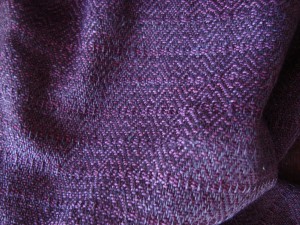
This is the most complicated threading that I’ve done yet, and it was a lot of fun. I definitely want to play more with complex weave patterns. So many things to try…
At the end, I had a few feet of warp left after I ran out of laceweight, so I switched to cotton and did some playing around.
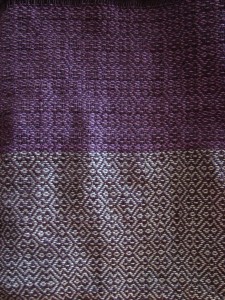
These are two different patterns that use the same warp threading, and you just lift the threads (treadle) in a different way. It’s interesting to me how much difference the weft color makes. I really love the dark laceweight, and the off white, but I don’t really care for the medium toned purple. The colors go well together, but I don’t like the way they interact with the pattern; I find it very hard to see. The off white looks great, though. I think I got enough of that one to make something with it, too.
I think the final finishing on these will probably have to wait until after the move. I did manage to hem stitch the ends of each of the coasters, but these larger pieces will take a little more time and work to get done. Still, I’m excited to know that they’re almost ready to use!
Once the coasters were finished, the little loom was left empty. We can’t have that, so this week I’ve been working on threading up a new project.
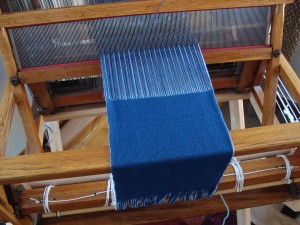
This is a new doubleweave warp. The first part wasn’t behaving quite as nicely as I wanted (I was trying to work too close to the end to avoid waste), so I wove about 10″ that I think will probably become a drawstring bag of some sort. I finished that just before leaving for the bus this morning, and now it’s on to potholders.
So that’s my weaving progress report. Two things off the loom, and another on. I wonder what I’ll get done this weekend?
Sun 27 Mar 2011
Not much has gotten done this week, I’m afraid. We heard back on the house, and they went with someone else.I was afraid of that, since one of the other people looking at the place seemed to know the landlord really well, and if I were in her shoes I’d go with my friend over a stranger. So, we begin the house hunting again.
My knitting has hit that awkward in-between stage where one project is done before another has quite taken off. (I seem to run into this problem a lot lately. Need to work on planning for the next project sooner.)
I’ve been swatching happily away for the past couple of weeks, using this as my bus knitting. It’s made great progress, and I’m excited about the stitches I’ve been coming up with.
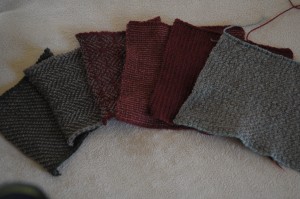
But then, last Sunday, I finished one swatch and just couldn’t figure out where to start looking for another. I’m working on “plain weave” textures right now, feeling my way through two-color linen stitch variations. I’ve tried quite a few, but haven’t found what I want just yet. I thought I had it two or three times this week, knit a few rows, and then realized that no, that still wasn’t it. There’s a lot of one step forward and two steps back in this project right now. I think it’s getting closer, but it isn’t moving yet.
The Namaste scarf has met a similar fate. I had swatched two different stitch patterns that I really liked in a similar yarn, and then bought this yarn to make the actual piece. I was home sick from work one day about three weeks ago, and I managed to get half a skein knit up. Yes, I have been that behind in blogging. I could have sworn that I’d taken pictures and blogged about it weeks ago, but can find evidence of neither. So, belatedly, here is the scarf I started:
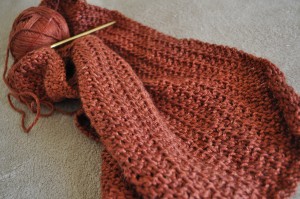
The problem is that I don’t like the stitch in this yarn. I love the yarn, and I like the stitch, but the two aren’t playing together well. I think the silk and the tencel together give the yarn a little too much drape where the stitch requires bounce. I knit as far as I did hoping that I’d suddenly like it once the fabric got to a size where I could really see how it hangs, but the next day I looked at it again and had to admit that it’s just not there yet. I like it, but it just doesn’t “pop.”
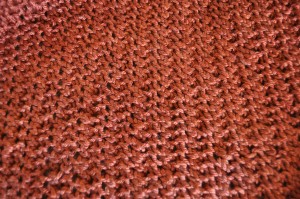
So, the scarf requires some more tinkering with stitch patterns and swatches. It’s amazing how hard it is to come up with interesting stitch patterns in fully reversible lace with simple repeats. I had fallen into two in a row almost by accident, but now it’s looking like others may be harder to find. That’s not a problem, but it requires time and brainspace to find what I want, and I’ve been rather short on both lately. And so, the Namaste scarf has also been put aside to ripen.
Unfortunately, nothing else has really been stepping forward to be knit, and so I have had an almost entirely knit-less week. I’m hoping to cast on for something this afternoon, or else it will be another week before I have time to figure out what’s next. (And it will be another week before I can get into the stash closet, since we have a houseguest coming tonight and there is now a twin bed set up in front of the closet door.)
So, here’s hoping for more knitting next week!
Sun 6 Mar 2011
About a week ago, Ellen took a picture of a cardinal. And then, she asked me if I could dye spinning fiber that looks like it.
My dyeing skill is definitely not to that level, but I love a challenge, and what’s a challenge but the opportunity to try something you’re probably not ready for? (If you want to see a master of matching photo to fiber, check out Ruth’s blog over at Impulse of Delight. I want every yarn that she dyes.)
There are two main challenges in this project. The first, is contrast. It’s easy to make yarns with subtle variegation. You layer on a bunch of colors, and you gently smoosh (yes, that’s a technical term) the dye together to mix and blend it as much as you like. For contrast, it’s a different story. Dye goes onto fiber as solutions, not really any thicker than water. It’s easy to let two colors bleed into one another, but it is hard to keep them separate. You can buy gels and thickeners to help out, but I’ve never used them and don’t want to add another layer of complexity to the process right now.
So, contrast. Hard. That photo even has two kinds of contrast; there is the contrast between very dark and very light, and the contrast between grey/greens and bright red. This is fiber for spinning, so there’s also the additional blending (i.e. loss of contrast) that you’ll get at the wheel from spinning multi-colored fibers together.
Contrast is challenge #1 in terms of difficulty, but it falls second in the process, at the stage where the dye goes onto the fiber and then again when the fiber gets spun at the wheel.
The first challenge is simply choosing which colors to use in the first place. I had the right greens right off, but the right grays just simply didn’t exist in my sample card collection. The gray in the photo is not a simple color; it’s a subtle mix of gray and blue in some regions, and gray and pink in others. Just diluting black wasn’t going to cut it, so I spent yesterday afternoon playing with all the different ways to add a hint of color to a pale, pale gray.
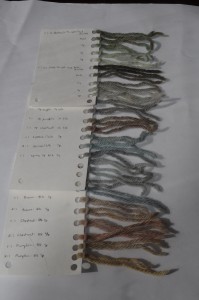
Predictably, I like the blue-grays and the green-grays the best, but I also got a pretty good range of pink-gray and even a couple of yellow-grays (though those are almost more like a pale mustardy brown, if you ask me.)
I usually prefer to use deep, saturated colors with a lot of intensity, but I am finding myself utterly charmed by these pale, pale colors. In their finest moments, the samples remind me a little bit of Blue Moon’s Spirit series, which I have always loved and will someday find an excuse to use. I never knit in white, but I love, love, love all those barely-there shades of color.
Even before Ellen asked her question about the cardinal, Branden and I had been discussing how to add a “suggestions” box to the website so that people can suggest color combinations and/or photos for me to play with when I’m dyeing. I don’t want to do custom orders (at least not as a general thing), because I don’t have and I just don’t want to have very precise control over my dyeing process. For me, a lot of the fun is in the magic of just seeing what happens, and I think that would get lost if I was focused on trying to match someone else’s vision. Or even my own vision, I suppose. I go to the dye studio with deliberately fuzzy expectations, and I’d like to keep it that way.
So the idea of custom “orders” is out, but I really enjoy working with combinations of color that I wouldn’t have put together on my own. I have a fairly limited personal palette, truth be told, and it’s really fun to step outside of it and dye something that I would never think to wear but that represents another person’s taste in my mind. I’ve dyed for friends four or five times, and I really enjoy the process of figuring out which colors will work for them, and putting them together in ways that surprise (and usually delight) me. Basically, I want the push outside of my box that custom dyeing would give, but without the pressure for me to get it perfect, or for the suggester to order if they don’t love what I come up with. Dyeing is always a gamble, and I never want someone feeling obligated to pay for something that doesn’t match their vision.
And that’s where the suggestion box comes in. People can suggest colors, combinations, general ideas (winter ocean, bali sunset…), or whatever else comes to mind, and I’ll put it on my list of ideas to play with someday. I might get to it immediately, I might get to it in a year. I might make a mess of it, or it might come out brilliantly. When the fiber/yarn is dyed, I’ll post it, and people can buy if they like it. If it’s not what they had in mind, it can find a home with someone else. I’ll get to play, and the shop gets filled with things that someone is likely to enjoy, and anyone who cares to read along will get to watch the journey.
The cardinal picture has been a really interesting pilot study for this idea. I’ve been thinking about it all week, plotting and planning ways to get the colors I want to work in the ways that I want them to work. It’s been a lot of fun so far, and it’s certainly opened up a whole new range of colors for me to explore, even if the final fiber isn’t what I hope it will be.
Thanks to Ellen for suggesting this current exploration, and for the rest of you, keep your eye out for a new suggestions form, once we figure out how on earth to make one that will do what I want. Surely there are some colors out there that you’d like to explore?







